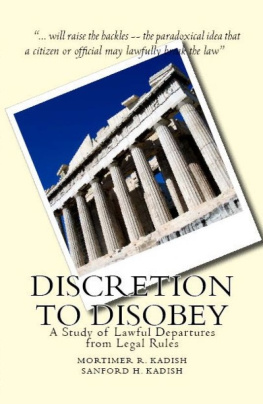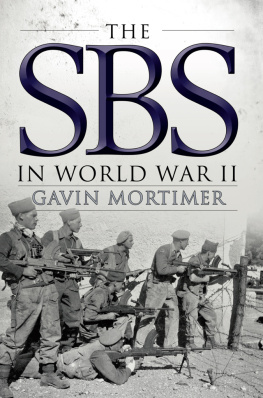Mortimer Kadish and Sanford Kadish - Discretion to Disobey: A Study of Lawful Departures from Legal Rules
Here you can read online Mortimer Kadish and Sanford Kadish - Discretion to Disobey: A Study of Lawful Departures from Legal Rules full text of the book (entire story) in english for free. Download pdf and epub, get meaning, cover and reviews about this ebook. publisher: Quid Pro Books, genre: Politics. Description of the work, (preface) as well as reviews are available. Best literature library LitArk.com created for fans of good reading and offers a wide selection of genres:
Romance novel
Science fiction
Adventure
Detective
Science
History
Home and family
Prose
Art
Politics
Computer
Non-fiction
Religion
Business
Children
Humor
Choose a favorite category and find really read worthwhile books. Enjoy immersion in the world of imagination, feel the emotions of the characters or learn something new for yourself, make an fascinating discovery.
- Book:Discretion to Disobey: A Study of Lawful Departures from Legal Rules
- Author:
- Publisher:Quid Pro Books
- Genre:
- Rating:3 / 5
- Favourites:Add to favourites
- Your mark:
- 60
- 1
- 2
- 3
- 4
- 5
Discretion to Disobey: A Study of Lawful Departures from Legal Rules: summary, description and annotation
We offer to read an annotation, description, summary or preface (depends on what the author of the book "Discretion to Disobey: A Study of Lawful Departures from Legal Rules" wrote himself). If you haven't found the necessary information about the book — write in the comments, we will try to find it.
Discretion to Disobey: A Study of Lawful Departures from Legal Rules — read online for free the complete book (whole text) full work
Below is the text of the book, divided by pages. System saving the place of the last page read, allows you to conveniently read the book "Discretion to Disobey: A Study of Lawful Departures from Legal Rules" online for free, without having to search again every time where you left off. Put a bookmark, and you can go to the page where you finished reading at any time.
Font size:
Interval:
Bookmark:
DISCRETION TO DISOBEY
A Study of Lawful Departures from Legal Rules
________ __
Mortimer R. Kadish
and
Sanford H. Kadish
___________
Classics of Law & Society Series
qp
Quid Pro Books
New Orleans, Louisiana
The Classics of Law & Society Series offers quality digital versions of the modern canon of scholarship in law and society, adding active tables of contents and linked footnotes and using care in formatting. Books in the Series, all written by renowned scholars, are recognized resources in their field and foundational works for later generations. They are part of the standard research library or classroom material on the topic, and have been read widely by the general public for what they teach us about law, history, politics, sociology, and philosophy.
Original work published in 1973 by Stanford University Press, Stanford, California.
Copyright 2010 by Mortimer R. Kadish and Sanford H. Kadish. All rights reserved.
No copyright is claimed in any quoted statutes, regulations, or excerpts from court opinions. The cover quotation is adapted from J. Levin, Review , 37 Modern L. Rev. 589 (1974), in reviewing the original hardback edition.
Published in 2010 by Quid Pro Books.
It is part of the Classics of Law & Society Series, Number One in the series.
ISBN:1610279565 (new ePub edition, 2012)
ISBN-13:9781610279567 (new ePub edition, 2012)
Publisher's Cataloging-in-Publication
Kadish, Mortimer R.; and Kadish, Sanford H.
Discretion to Disobey: A Study of Lawful Departures from Legal Rules / Mortimer R. Kadish and Sanford H. Kadish.
p. cm.
Includes Preface and Notes by the Series Editor; and bibliographical footnote references.
"A classic book of law and philosophy in which the authors explore the many ways in which law contains the conditions and procedures for its own departures. Sometimes law is legitimately made by breaking it."
1. LawUnited States. 2. Jurisprudence. 3. Criminal law. I. Title.
qp
Quid Pro Books
Quid Pro, LLC
5860 Citrus Blvd., Suite D-101
New Orleans, Louisiana 70123
www.quidprolaw.com
To the memory of
Fanno and S.J.
TABLE OF CONTENTS
Text:
The Justification for Undertaking an Action
Acting in Roles: Citizens and Officials
Rule Departures in Roles
The Rule-of-Law Model and the Official's Role
An Alternative Model: The Criminal Jury
The Concept of Legitimated Interposition
Legitimated Interposition in Other Roles
The Law-and-Order Model and the Citizen's Role
The Concept of Legitimated Disobedience
Legitimated Disobedience and the Norm of Validity
Legitimated Disobedience and the Norm of the Lesser Evil
Legitimated Disobedience and the Norm of Justifiable Nonenforcement
Summary
Interposition and Disobedience Contrasted
Legitimation as a Response to a Dilemma
Openness to Legitimation in Legal Systems
The Values and Risks of Legitimation
Principles of Acceptance in Legal Systems
Principles of Acceptance and Legal Theory
An Alternative Model of a Legal System Checks and Balances
An Alternative View of Legal Obligation
On Conceiving of the Law
License Notes for the digital edition
...what to look for in this edition of Discretion to Disobey
After its original publication in November 1973, this book was soon recognized as an important contribution to the study of protest and lawful change in U.S. society during a tumultuous era when the distrust of legal institutions was acute, as was the need for responsible response to their sweeping powers. The daily-emerging Watergate story, recent overreactions to protests, and the winding down of the Vietnam War (and discovery of atrocities there) all revealed that trusted governmental actors had failed us. And yet the rule of law had to be maintained. How best to support the worthy ideal of the rule of law while profoundly challenging and upsetting the rules and the law was, and remains, more than a mere tension, a difficult puzzle. This book was immediately considered a major effort at working through that puzzle. And still today, nothing is simple; emphasis is everything, as they wrote at the time.
Just on the level of an academic feat, this book was, and is, a successful work in law and philosophy. Often, studies in that genre are more one than the other, and the marriage of the two disciplines is uneasy. Not so in this case, as it was the joint product of a respected philosopher, Mortimer Kadish, in synch with this brother Sanford, a lawyer by training and an equally acclaimed professor of law. It became a dialog between the disciplines of law and philosophy that resonates today, now involving a new generation of readers confronting their own question: what do citizenship and a call to action mean in the face of lawful authority sometimes wielded to serve not the public good but rather the petty and impatient, or even corrupt, purposes of legal actors? How to follow a law when to break it is more just?
To respect that effort and the reader, I have tried as much as possible to recreate this work as the authors envisioned it. Even so, the digital format has its own universe of rules, and I have adapted the book slightly to stay true to that vision and that universe. To this end, digital books typically use mutable locations rather than fixed pages (to accommodate font sizing and text to speech). Nonetheless, in this version I have indicated the original page numbers at key breaks along the way; they are re-introduced by {brackets}. Pagination follows the standard 1973 edition produced by Stanford University Press and is consistent with the publishers later paperback printings. Anything else in { } is added by me, to clarify. Some further notes to the digital format:
The footnotes are numbered sequentially throughout, starting with chapter 2. In the original, footnotes re-started at upon each new chapter. For citation purposes and to make the notes cross-references usable, I have cited the original footnote number in {brackets} at the beginning of the chapter, starting with chapter 2, and at fixed locations along the way. All original footnote numbers may be readily deduced from these markers.
The footnotes are now mostly endnotes, as they must be in an ebook that is not fixed. Yet in most formats the notes are linked, to jump easily. Fortunately, in the original, source materials and citations appeared as endnotes, and that format is maintained. However, in occasional places the authors also used a true footnote on the page to clarify a textual point in a significant way. To honor that intent and to maintain the correct numbering of the endnotes, I have turned these few footnotes into textual insertions, set off and marked as such just below that paragraph, with brackets for my marker. (I have done this as well with the only two endnotes, both brief, in chapter 1.) In a few places in which the note was very brief and could be incorporated in text simply as a parenthetical, I did that. Digital books simply do not allow for such diversity of footnoting, but I believe the use of a few textual asides works and comports with the original presentation.
All cross-references include my bracketed notes to easily locate the material under the original numbering.
I have made minor, consistent spacing changes throughout for legibility and proper ebook formatting without changing the words or quotability in any way. For example, block quotes are indented.
This edition was designed primarily for a digital platform, where the gap in accuracy, proper formatting, and usable footnote references is typically greatest. It can be read not only on dedicated ereader devices, but also using free ereader applications on such devices as a Windows PC or laptop, Mac, iPhone, iPad,BlackBerry, Android, and other smartphones. It is also available in simple PDF and rtf files. Other digital versions for various devices are linked on www.quidprobooks.com.
Next pageFont size:
Interval:
Bookmark:
Similar books «Discretion to Disobey: A Study of Lawful Departures from Legal Rules»
Look at similar books to Discretion to Disobey: A Study of Lawful Departures from Legal Rules. We have selected literature similar in name and meaning in the hope of providing readers with more options to find new, interesting, not yet read works.
Discussion, reviews of the book Discretion to Disobey: A Study of Lawful Departures from Legal Rules and just readers' own opinions. Leave your comments, write what you think about the work, its meaning or the main characters. Specify what exactly you liked and what you didn't like, and why you think so.










